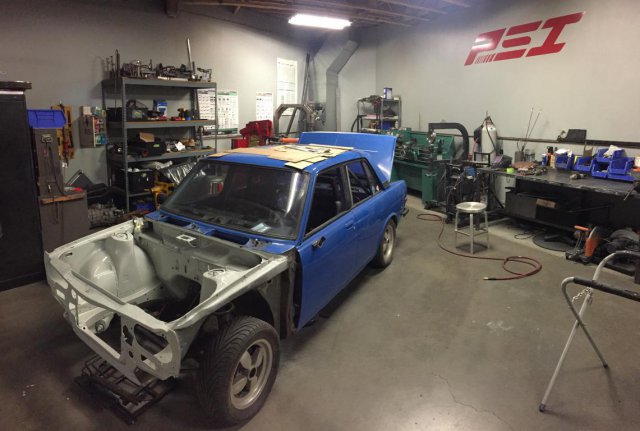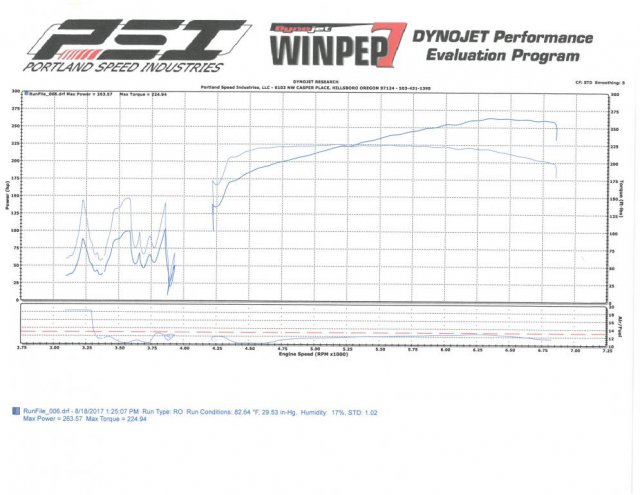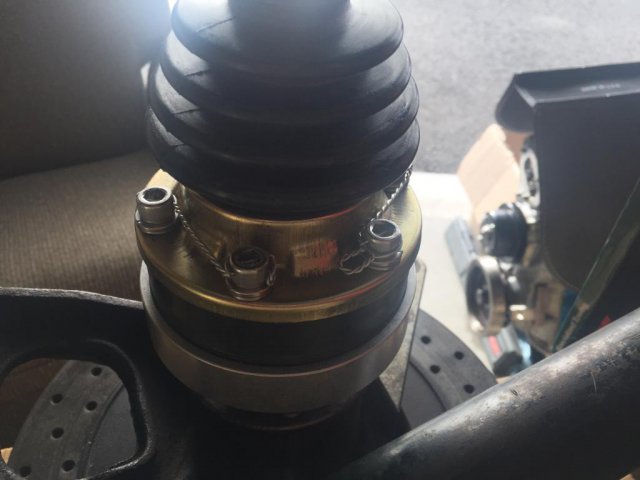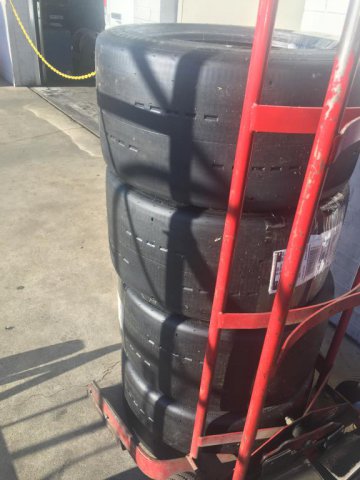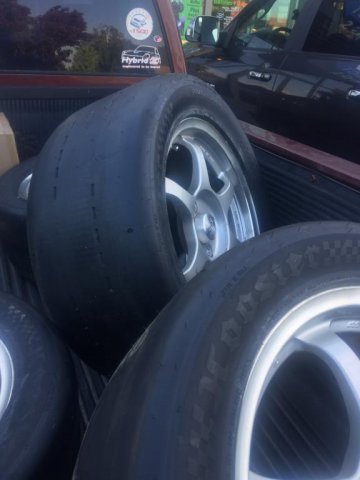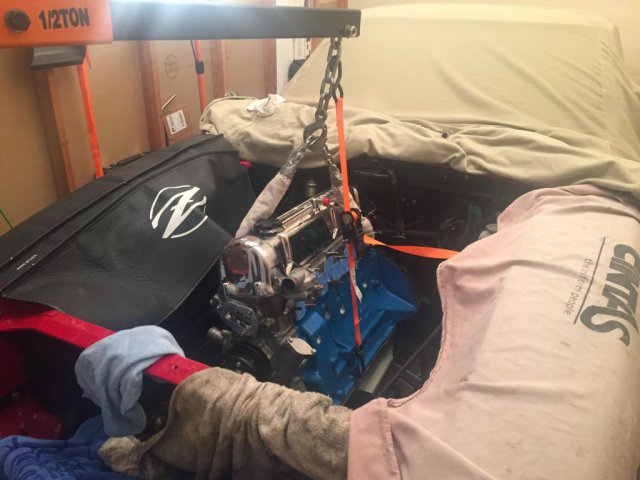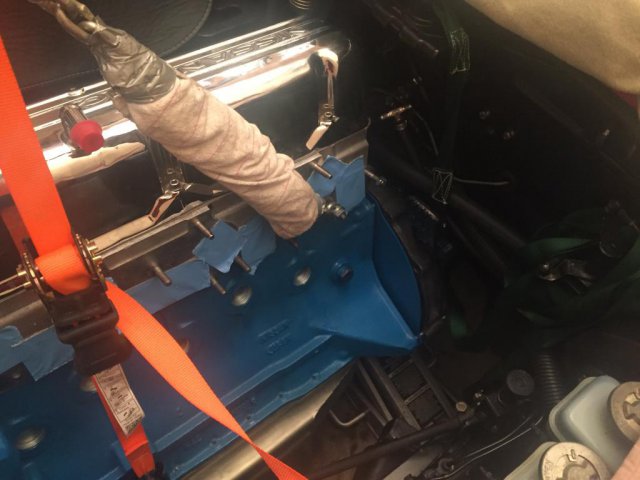-
Posts
536 -
Joined
-
Last visited
-
Days Won
8
Content Type
Profiles
Forums
Blogs
Events
Gallery
Downloads
Store
Everything posted by zredbaron
-

NA 3.1L=>head & camshaft questions. No shortcuts, max
zredbaron replied to zredbaron's topic in Nissan L6 Forum
I also omitted that I had two techs helping me the first day, a general mechanic and an electrician. My lithium battery didn't survive their techniques, despite me highlighting bold warnings from Braille (the battery manufacturer). I was arguing with experts in their back yard, and I've previously been burned by my ignorance / arrogance (having gone down similar roads in the past). This time, I was the expert. I had technology they didn't have an education on, and I was the one that read the manual. They were good guys, genuinely trying to help. Expensive battery, made to order, ships via ground only. Sometimes the story just hurts so damn much you don't want to say it out loud. Especially when you were right but allowed wrong to happen. Always go with your gut. -

NA 3.1L=>head & camshaft questions. No shortcuts, max
zredbaron replied to zredbaron's topic in Nissan L6 Forum
Agreed! Simply stated, this dyno session is for data about stacks, so I and others can select appropriate parts for our application(s). (It is explicitly not a dyno session to dial-in "my" engine.) (Is it even mine? John Coffey's head and cam R&D, Jim Thompson's work, Joe Harlan's work, and "my" combination of go-fast parts that others invented or recommended.) I don't know if I will still be using the Electromotive loaner unit, my old unit or a new-to-me unit. So... for the purpose of venturi comparison, I will do a few pulls at the beginning of the day with the Weber long stacks and refine my timing knobs for the baseline setup. I don't anticipate revisiting timing, as I don't anticipate having much spare time. The XDI ignition doesn't have a TPS input, but I do have a MAP sensor installed. It's been hooked up for years. I don't notice much difference when it is unplugged (I do have a lot of cam overlap, after all), but then again I haven't unplugged it in years. It's worth a revisit. A waveform is a waveform. If the peak high and peak low is sufficient, then, depending on circuit design, a crude waveform will easily become a clean square wave. (This doesn't mean it sees a consistent frequency.) The integrated OPAMPs within the Hall Effect sensor do help clean up waveforms, but the tech seemed to think the later model likely worked due to the upgraded onboard signal logic. It does some intelligent filtering also. [Electromotive final analysis still to come.] This is a very painful and long story. I missed two race weekends, an engine dyno and my first ProSolo because I refused to "just put the mechanical pump back on." This is still quite abridged. Car wouldn't start. Autometer gauges didn't pass their startup test with key in IGN position. Unplugging a spark plug wire and connecting a spark tester (term?) to ground revealed the coils were firing, with crank at rest. Unplugging water pump immediately stopped the sparking. No water pump: gauges pass startup tests, car fires right up. Plugging water pump back in and unplugging mag sensor also stopped the sparking. Moving the mag sensor around the engine bay resumed sparking if mag sensor was within about 6" of either the pump or the damper (the damper is magnetic, therefore it builds up a field, also). Placing shielding between the sensor and the pump was effective with mag sensor in hand, but ineffective with mag sensor installed. (I spent a lot of time on shielding attempts, trying to MacGyver my way through the weekend.) The solid damper (BHJ?) truly exacerbated this field condition. Shielding attempts would delay the onset of when spark would occur. Depending on shielding, sparking would delay 10-90 seconds even. (With the 12A pump running.) I'm not an electrical engineer, but this is definitely indicative of a buildup of inductance, I reckon. (My theory: shielding is impossible. HAS to be solved by Hall effect / chip logic, etc. Why? The engine block is a big piece of iron electromagnet.... big magnets take more energy / time to build a field. Shielding slows it down but since pump is installed metal on metal to the engine... shielding can't help you.) Calling Electromotive resulted in "oh yeah, that's why we made the Hall Effect sensor, part no...." Part arrived. The instructions indicated those with "serial numbers less than..." were to call Electromotive. I called Electromotive. "You have to send us your unit and we can modify it to be compatible with a Hall Effect sensor." I send my unit to them, they send it back. Mod doesn't work. Mag sensor doesn't work anymore either. They overnight me a loaner unit. Doesn't work at first, but it was my fault this time - the jumper wasn't fully seated. (the later serial numbers allow Hall effect sensors by installing a jumper. earlier models like mine need to be opened up and hacked.) Sure is nice when stuff just works and your car just fires right up when it's supposed to! Thanks Leon! You've already been of influence. Speaking of engine temps... my engine keeps pretty consistent temps. It's running the 10qt oil pan from DRP and the aluminum radiator from Arizona Z with dual fans. On the road and at events (doesn't idle very long), the water runs at whatever temperature I set the thermostat. Dyno pulls with electric fans only is another story... I seem to recall it needing to cool down in Portland now that you mention it. EDIT - How does one monitor under hood temps? Such as the intake manifold and carburetor bodies. Ideas or experience? Heat gun on a few areas? -

NA 3.1L=>head & camshaft questions. No shortcuts, max
zredbaron replied to zredbaron's topic in Nissan L6 Forum
Thanks Leon, good feedback. Your profile slogan is particularly on cue here. Hah! I've prepared ahead on the swapping parts routine, definitely changed my hardware and tools in the process. Jon M and Joe H can attest that I've learned the swapping parts lesson a couple of times now. Clearly didn't learn the first time. Feeling confident this go-around. Good call on the tire pressures! I likely would not have thought of that. I'll be sure and warm up the drivetrain as I arrive, too. I'll also take a log on temperatures as I am able. I'll print a table. Everything will be with an informed grain of salt; at least it's the same car on the same dyno, same day. Agreed, there will not be enough time. But, I can certainly say there are enough variables that I won't lack for options to follow hp/torque or data collection. I imagine my plan of attack will adapt as the day unfolds. -

NA 3.1L=>head & camshaft questions. No shortcuts, max
zredbaron replied to zredbaron's topic in Nissan L6 Forum
Hey gang. The bad news: Surprise! Dyno dates postponed two weeks to May 18, 2018 due to unforeseen challenges. The short version is that I upgraded my mechanical water pump to an electric water pump, and the EMF (electromagnetic field) was passed through the damper and felt by the crank sensor 8 inches away. The ignition system would spark with the crank at rest and water pump running, so starting was impossible. The solution was to upgrade the magnetic pickup to a powered hall effect mag sensor, which doesn't get fooled by ambient signals as easily. The abridged long version is a two week saga with Electromotive (A++ field support!), in the end sending me two hall effect sensors and a jumper for the computer module that didn't work. I sent them my unit, they opened it up and upgraded the hardware to allow for hall effect sensors and sent it back to me, but it still didn't work. They ultimately sent me a loaner ignition module that fired right up. Evidently my early-model XDI had an onboard logic chip that was only a part of the early serial numbers of the XDI. This is actually my third Electromotive module, having owned the HPV-1 and HPV-X in the past. I'm very loyal to their technology and product, especially after their A++ service these two weeks! They may or may not have overnighted the loaner unit to me on a Saturday, and called me proactively on that weekend. Wow! (I mention this not to suggest others should expect the same level of service, but to remove any doubt as to the reliability of their products-- follow through in the field is how they ensure their technology is reliable. It "should" have been different and they wanted to figure out why! They did. Also: very, very few customers have the early unit I do.) Pics show green and white jumper attempts, the proper hall effect mag sensor, the new loaner XDI module, and the electric pump. The good news: I have SIX SETS of venturis, OH MY! My plan of attack, at Kaizenspeed's dyno, on 5/18/18: Ambitious, as always! Run 40mm venturis (chokes) for all runs When possible, run the same jets... and use the changes in A/F ratio as "apples to apples" O2 availability for combustion comparison. (As time allows, main jetting changes as well... allowing "apples to apples" HP comparison.) Insert sleeves Aftermarket air horns do not slide into the carburetor body. Sleeves are 1mm thick, which is a 2mm difference in ID. The carb body is 50mm OD, expecting the sleeve to be inserted. The Weber sleeves are 48mm ID The Pegasus airhorns are exactly 48mm ID The issue: Without sleeves... diameter goes from 48mm to 50mm (square edge!) and then 50mm back to 48mm (square edge!) Sleeves vs. no sleeves will likely matter. The R&D: My first two velocity stacks will be the Weber long and Weber short Whichever performs less well will be taken a machine shop down the road that morning and cut flush, retaining the sleeves and ditching the velocity stack. Machinist time is prescheduled, and I have a friend as a "runner." This will then be paired with all external aftermarket stacks, same dyno same day. As time allows, I will also compare with and without sleeve for a couple of stacks. Butt-dyno / driveability confirmation Top 2 or 3 also be road tested to confirm mid-throttle torque performance WOT isn't what I am after, in the end. Later this summer, at my engine builder's chassis dyno, timeframe TBD: Compare (top 2?) air horns inside an airbox (still working on my frankenbox, but making progress as I have commissioned some pieces that will be ready this week) Compare 38mm and 40mm venturis -- confirm theories about torque Possibly compare one last air horn design, a stubby shape, also inside the air box. My theories: Aftermarket stacks with sleeves will outperform aftermarket stacks without sleeves. Air horns with sufficient conical shapes ("ram tubes") will accelerate the air enough that "small" venturis/chokes will no longer be necessary to retain low RPM torque. (I have been running 38mm chokes for low RPM torque and drivability.) With different stacks, I expect to see various HP and torque gains across the entire RPM band. With the top stacks, I expect to see negligible sacrifice in torque and uncapped peak HP (possibly not confirmed until later, data TBD). Why am I doing this? Without HybridZ, I wouldn't have the car I have today. Without others having pioneered the way, WE wouldn't have the performance we enjoy today. Without open sharing, neither bullet point exists. Big thanks to the donor(s) so to date! If anyone has any advice, thoughts, experience or requests... please speak up! -
I've no doubt you're spot-on! Care to elaborate?
-
I can also add that once performance driving is tasted in an environment where it is safe to go beyond the traction envelope and spin out without harm.... you'll see the street never could have delivered the goods. "Adulthood" is a different pursuit entirely. ;) [Insert Peter Pan reference.]
-
Concur 100%. In my experience across several states, Zs only have a chance at truly being competitive in FP. Other classes will have cars that we can't keep up with, if they show up. It's never fun to be the only car in your class and "win." Like all forms of racing, one must maximize class allowances to allow the driver a chance to compete. The S30 just isn't a platform for competition against a modern car. It is however that platform that connects driver to the road most directly. Our Zs are among the most exciting cars to autocross in terms of adrenaline for this reason. Racers with faster times get out of my Z hooting and hollering. I'm with Jon. I target competing against a few cars or drivers. I prefer to have a passenger than drive alone. Why hog the adrenaline? Get in! I pursue excitement. I feel like I win, because I'm driving my dream car since I was 17. And that's my best victory, really. FWIW.
-
Super Street Modified (SSM) is another class the Z can find itself in. You can have a stroker, add a turbo, even an RB26 swap with huge fender flares. It simply requires a few "street" items like a dash and carpeting. It is the "street" version of X Prepared (XP). Great advice given above. No one will care what class you're in until you win, or unless it is an SCCA club with numerous hall monitors ("fun" police). Pick a class, explain to the club that you're new, and people will take you under your wing and help explain the classes while you walk the course. My advice would be to show up as soon as your car is road worthy. Not competition worthy... road worthy. Seat time is worth quite a lot.
-

NA 3.1L=>head & camshaft questions. No shortcuts, max
zredbaron replied to zredbaron's topic in Nissan L6 Forum
We're back online! Woohoo! I have a lot of updates, such as exhaust and other upgrades... but first, let me get the time-sensitive matter out there on the internet! (I posted the following yesterday on the triple weber thread, believing it to be this thread. Oops. Mostly duplicate content for those of you who are subscribed to both.) Many thanks to the admins for restoring "Reply to Post" functionality! I have been kicking the "chassis dyno R&D" can down the road long enough. I have an appointment for Friday, May 4, 2018, which could get delayed a couple weeks if I am waiting on overseas shipping. Unfortunately, an air box will not be an option for this round of dyno pulls. My custom strut braces have really meaty and obstructive flanges. However, I plan on doing intake volumetric efficiency research with regard to venturi diameters (38mm and 40mm) and the effects of combinations with various velocity stacks ("air horns" / "trumpets"). Here are my top air horn picks I am considering: For testing lengths, I like: http://www.emeraldm3d.com/throttle-body-kits/emerald-adjustable-length-intake.html Ideally, this would give us an idea how length of the air horns affects or doesn't affect performance Dyno will only be valuable for WOT. Butt-dyno runs will also be needed to confirm drivability. I'm told by the vendor this doesn't likely fit the DCOE carburetor internally. :'( Currently awaiting email reply after sending measurements of my Weber "trumpets" (velocity stacks) For testing shapes, I like: https://store.jenvey.co.uk/throttle-bodies-and-components/air-horns (they recommend their "40mm stack with a 50mm throttle body" - not quite apples to apples) EDIT - if ITBs were ever in this car's future... it appears Jenvey is a quality vendor choice that I didn't know about http://www.palmside.co.nz/product_cid_10899.html (won't ship to USA???) (I really like the flared shape of these.) https://www.pegasusautoracing.com/productdetails.asp?RecID=1257 (currently awaiting shipping confirmation from vendor) EDIT - I forgot about Techno Toy Tuning! https://technotoytuning.com/nissan/kgc10/velocity-stacks-carbs I like these flares more than the Pegasus stacks, they seem like they would be more helpful at varying velocities of airflow. These are now my favored single purchase. Any other recommendations or considerations out there? In my mind, a given length is best, and a given shape is best. These are not necessarily mutually exclusive. I predict the adjustable length will show a "good performance range" (but not a clear "winner") and choosing various shapes within this range would reveal optimal combination(s) for a given application and intended usage. Again in my case I seek a wide, flat torque curve and not peak HP. Perhaps the data will be clear, but I'm assuming a butt dyno / road test will likely have to confirm / deny the shape winner(s), especially if some combinations are comparable. WOT hp numbers are not what wins an autocross race. If anyone is interested in contributing their 45mm air horn shape to this shared research, please message me. I would be happy to return them to you after chassis dyno testing is complete. It's likely I will only be able to afford one set of air horns to test alongside the issued Weber air horns. Alternatively, air horns, race fuel and dyno time are effing expensive. If anyone is feeling charitable and wishes to donate some coin, that would be appreciated. This project is financed by credit and cash loans; I'm "all-in" with this S30 project. Maybe some others relate? If the adjustables fit, I will find a way to source them and I will intend to pass them on to another racer in our community. Or maybe my engine builder as another thank you. Some say gains won't be made here. Perhaps in peak hp this is overwhelmingly tried and true, but in terms of area under the curve, I defer to Ferrari and other performance companies who have engineered variable length intakes. If it was a gimmick, it wouldn't be on a supercar. We don't have this data publicly available for our L6s. Let's change that. -

Weber jets??All who live for their triples please read this
zredbaron replied to datfreak's topic in Nissan L6 Forum
We're back online! Many thanks to the admins for restoring "Reply to Post" functionality. EDIT -- I mistakenly thought I was posting the below post to my engine thread. Oh well! It seems appropriate for this thread too. I have been kicking the "chassis dyno R&D" can down the road long enough. I have an appointment for Friday, May 4, 2018. Unfortunately, an air box will not be an option. However, I plan on doing intake volumetric efficiency research with regard to venturi diameters (38mm and 40mm) and the effects of various velocity stacks ("air horns" / "trumpets"). Here are my top air horn picks I am considering: For testing lengths, I like: http://www.emeraldm3d.com/throttle-body-kits/emerald-adjustable-length-intake.html Ideally, this would give us an idea how length of the air horns affects or doesn't affect performance Dyno will only be valuable for WOT. Butt-dyno runs will also be needed to confirm drivability. For testing shapes, I like: https://store.jenvey.co.uk/throttle-bodies-and-components/air-horns (currently awaiting their recommendation) http://www.palmside.co.nz/product_cid_10899.html (won't ship to USA) https://www.pegasusautoracing.com/productdetails.asp?RecID=1257 (currently awaiting confirmation from vendor) In my mind, a given length is best, and a given shape is best. These are not necessarily mutually exclusive. I predict the adjustable length will show a "good performance range," and choosing various shapes within this range would reveal optimal combination(s) for a given application. Again in my case I seek a wide, flat torque curve and not peak HP. Perhaps the data will be clear, but I predict a butt dyno / road test will likely have to confirm / deny the winner(s), especially if some combinations are comparable. WOT hp numbers are not what wins an autocross race. If anyone is interested in contributing their 45mm air horn shape to this shared research, please message me. I would be happy to return them to you after chassis dyno testing is complete. Alternatively, air horns, race fuel and dyno time are effing expensive. If anyone is feeling charitable and wishes to donate some coin, that would be appreciated. This project is financed by credit and cash loans; I'm "all-in" with this S30 project. Maybe some others relate? Some say gains won't be made here. Perhaps in peak hp this is true, but in terms of area under the curve, I defer to Ferrari and other performance companies who have engineered variable length intakes. If it was a gimmick, it wouldn't be on a supercar. We don't have this data publicly available for our L6s. Let's change that. -

Kindred Philosophy - S30 Owners (+ generational Z family)
zredbaron posted a topic in Non Tech Board
I've always wanted to see a philosophy thread on HybridZ. It never ceases to amaze me how unique and quirky the Datsun following tends to be... and even more so how much we have in common despite are differences in backgrounds, etc. There are a lot of generalizations that can be made about people drawn to American muscle cars, German performance and luxury, etc. In my experience Z owners tend to be very smart individuals relative to the general population as well as automotive enthusiast groups. (Clearly we have fine taste.) This could go a number of philosophical directions, about kindred human passions, the living spirit of Mr. K, the brand of Datsun's emergence after WW2's bombs, the commonality between Z owners.... you could even present an esoteric possibility such as Z owners' souls tend to come from the same quadrant of the galaxy or something about how HybridZ [sometimes] epitomizes focused, collaborative human achievements. All are of interest to me... but rather than lay my interests and thoughts out, I'd like to ask if others have had any similar observations and have pondered their implications or meaning? -
Hey guys, it's been a year or so since I've signed on. I'm having this issue also. Oddly, I was about to PM an Admin when I noticed the reply button on this page. It was NOT here yesterday on this PC or on my mobile device....? Weird. Hoping to reply to these topics specifically: http://forums.hybridz.org/topic/24798-na-31lhead-camshaft-questions-no-shortcuts-max/?page=17 http://forums.hybridz.org/topic/28318-weber-jetsall-who-live-for-their-triples-please-read-this/?page=34 Any advice out there? Perhaps trying again randomly? Thanks!
-

NA 3.1L=>head & camshaft questions. No shortcuts, max
zredbaron replied to zredbaron's topic in Nissan L6 Forum
Thank you, gentlemen! John -- the CV axles are from Wolf Creek Racing, and they are a great product. Great to see you're still out there! Ryan -- the muffler is 14" long, and is a 4" diameter (Magnaflow 14419). The "race" muffler option was 6" diameter and 6" long (Magnaflow 14159). Longer mufflers are quieter, despite how thin the first option is. Personally I don't think it's all that loud, I think the muffler does a great job and the exhaust has very little resonance. That said, many of the clubs here in WA have a 96 dB sound limit, so I guess I'll find out one way or the other! I'm close, no doubt. There's room for a 2nd muffler downstream should it come to that. I'm a huge fan of Magnaflow straight-through mufflers. Wonderful, rich tones. I first installed one on my 240Z in 2004. Liked it so much I run dual Magnaflow exhaust on my truck, too. -

NA 3.1L=>head & camshaft questions. No shortcuts, max
zredbaron replied to zredbaron's topic in Nissan L6 Forum
Chassis dyno and fabrication follow-up from this past weekend. Picked up my car from Portland Speed Industries in Portland, OR. Great shop for fabrication and setup needs! They also have a chassis dyno, so for me, it was a one-stop trip to Portland. Phenomenal work on the 3" exhaust. They mounted the muffler in the transmission tunnel. Not sure why I didn't take a good picture of the muffler itself. The strut bars were what I was looking for, too. I didn't initially imagine the assymetrical shape of the front brace, but after getting used to it, I really like the fabricator's approach. Nice and tight, too. The chassis dyno experience wasn't what we were hoping for. Joe came to help with the tune, and Jon Mortensen came down from Seattle again to see "carb/dyno tuning done efficiently." Unfortunately, the shop had double-booked the dyno and didn't tell me / us. Once my car was on the dyno, the shop manager simply needed help and couldn't be in two places at once. We could have performed our pulls in under 90 mins had he or a tech been at our disposal. Such is life. As for the car... we didn't have enough jets to tune it. The shame! LOL. 65F8 idles were too small for a proper transition. The engine kept leaning out once the cam kicked in above 5000, and we aborted several runs. 185 mains were the biggest I had, and they weren't having much effect. We tossed in the smallest air correctors I had, 145, and surprisingly that dropped us into the operable AFR and we completed a pull. 264 whp, 225 ft-lbs at 6300 so far, with a nice, flat torque curve. Once it gets going! Haha, ugh. Graph attached. https://www.youtube.com/watch?v=9__Kb_ZBIpY A fantastic start considering the main jets aren't even correct, so nothing else can actually be dialed in, including final timing. I've since reduced the chokes to 38mm from 40mm and performed a road test. Per my wideband O2 sensor, it brought the AFR back in line, no sweat. So... I'll just have to do another chassis dyno for a final tune once I have a sufficient range of jets available. Chassis dyno follow-up will occur within 30 days. -

NA 3.1L=>head & camshaft questions. No shortcuts, max
zredbaron replied to zredbaron's topic in Nissan L6 Forum
Thanks! Forgot to mention that my electrical issues were twofold.... a fried alternator and a fried hazard switch / pigtail harness. Replacing the alternator and removing the switch + harness restored the electrical system. Jon, I'm thinking I might attend the Saturday practice event and Sunday race in Shelton on Aug 12-13 (Western WA SCC). -

NA 3.1L=>head & camshaft questions. No shortcuts, max
zredbaron replied to zredbaron's topic in Nissan L6 Forum
Weird, this file didn't want to upload to HybridZ for some reason. YouTube workaround: https://www.youtube.com/watch?v=1cH8EFWg3Ks -

NA 3.1L=>head & camshaft questions. No shortcuts, max
zredbaron replied to zredbaron's topic in Nissan L6 Forum
Success! After many obstacles... I have successfully road tested my Z and deem it ready for suspension tune and chassis dyno. This Friday I will deliver the car to PSI in Portland for exhaust, strut bars, alignment and corner balance. Aug 11th is my appointment on the chassis dyno! Untuned road-test media attached! Huge thank you to all contributors, most notably Joe Harlan and Jon Mortensen. Thank you all! Rev Limit.mov -

NA 3.1L=>head & camshaft questions. No shortcuts, max
zredbaron replied to zredbaron's topic in Nissan L6 Forum
Thanks fellas. I delivered the car to an electrical specialist. Turns out alternator is fried, so far, which I'm almost certain was my fault for a brief moment while assembling the engine. Weird that it was functional for "a while" and then spontaneously gave out while unattended? Electrons are quirky critters. I have no reason to suspect my Li battery. Agreed, even an in-depth electrical repair will be less costly than simply replacing the battery! Haha. A ridiculous statement, now that I type it. My exhaust / strut bar fabrication and corner balance appointment in Portland is pushed back to July 28, with a pickup and chassis dyno on Aug 11. You're right. The engine is still solid. And I find myself more and more appreciative for the well-reputed engine dyno break-in... thanks Joe and Arnie! Projected first local autocross event will be September 9-10. (They do 4 events in 2 days here!? Wow. Sand and Sage Sports Car Club.) Jon, do you have any events in the Seattle area in August? It's almost time... -

NA 3.1L=>head & camshaft questions. No shortcuts, max
zredbaron replied to zredbaron's topic in Nissan L6 Forum
Still here, though I'm rather fatigued. I'll spare the list of challenges, I really don't care to write them out. Drilling through the clutch fork, under the car, took the cake last month, for sure. Wow, that's the hardest metal I've ever had the frustration to modify. I achieved driving the car onto the trailer under it's own power... and much has fallen apart since that moment. Literally 2 hours later, and < 1 mile from my road-test playground, my truck engine gave out after 286,000 miles. I've since had a series of challenges getting a crate motor delivered. Seriously. I traveled out of country, which didn't help either. I had to delay delivery of my Z to the fab shop in Portland for two reasons... tow logistics, and now, spontaneously, I am having electrical issues in my Z. Nothing has been touched! Could be ignition or relays, I suppose, but it's odd behavior. Flashers and fuel pump click on and off, as do most electrical loads, with the key out of the ignition. No troubleshooting yet -- I disconnected the battery and went and had a drink. But hey, I drove it 10 feet.... progress is progress. Even if it's about as frustrating as I've ever experienced. https://youtu.be/wKsXf-ihOc4 -

Weber jets??All who live for their triples please read this
zredbaron replied to datfreak's topic in Nissan L6 Forum
Interesting. Which surfaces did you find "not flat?" -

Weber jets??All who live for their triples please read this
zredbaron replied to datfreak's topic in Nissan L6 Forum
Perfect, that's what I was hoping to hear! Piece of cake. Thanks Steve. They're brand-new except for a few hours on the engine dyno back in October. -

Weber jets??All who live for their triples please read this
zredbaron replied to datfreak's topic in Nissan L6 Forum
Hey guys. I’m getting ready to install my new 45 DCOEs and two of the three carburetors have “sticky” throttles. I uploaded a YouTube clip for demonstration purposes. My Weber book is in storage and I didn’t see any relevant hits in the search results. I’m hoping it’s just the bolts on the side of the butterfly valve, perhaps they are too tight or need some lubricant. Anyone have any experience or tips here? I’d prefer to not start tinkering randomly… Thanks! https://www.youtube.com/watch?v=jysf3Tbx4nw -

NA 3.1L=>head & camshaft questions. No shortcuts, max
zredbaron replied to zredbaron's topic in Nissan L6 Forum
Still making progress. I haven't finalized a fabrication shop... but the rear suspension and drivetrain mods are complete and I'm happy to announce that my heart has officially mated with my body. Details.... so painful along the way, but so worth it forever after. IMG_7853.MOV -
Hey Steve... I really enjoyed reading your build thread. You did a great job capturing your progress, challenges and breakthroughs. I had several smiles this morning with my coffee. Triple DCOEs have a steep learning curve indeed! I assume you have 34 or 36mm chokes / main venturis in your 40 DCOEs? With a stroker... 34-36mm chokes are mandatory. I'd say 34mm for your build, as the 36mm don't offer much power gain and the 34mm have better drivability. Cheers, my friend. Nice work!
-

Weber jets??All who live for their triples please read this
zredbaron replied to datfreak's topic in Nissan L6 Forum
Sorry about the delay! Carbs can receive too much fuel pressure, in which case performance degrades. Installing a return line acts like a shunt, or a relief valve, in that it would relieve overpressure (to a degree; it isn't a pressure regulator) via providing a path of lesser resistance for fluid flow. If memory serves, the Webers don't like much pressure... 3.5 to 4 psi. I don't have my book handy. In my mind, pressure surges up to 6 psi would likely degrade performance, and a return line might alleviate that symptom.






